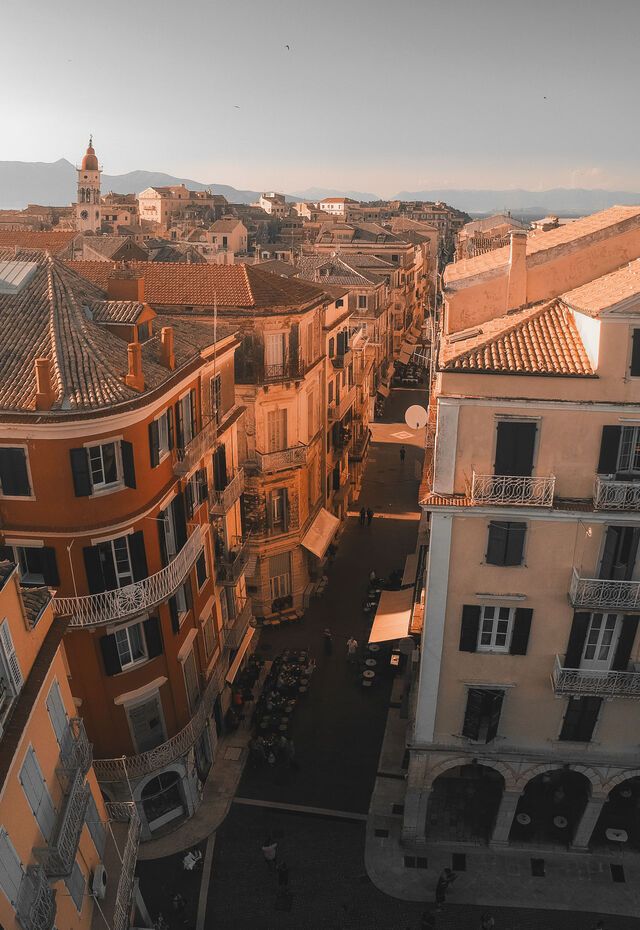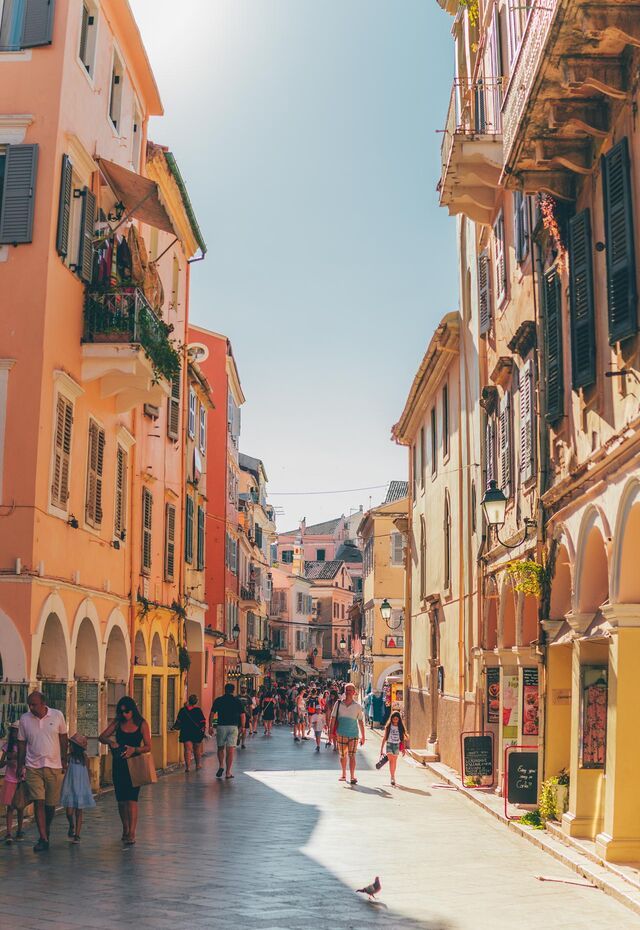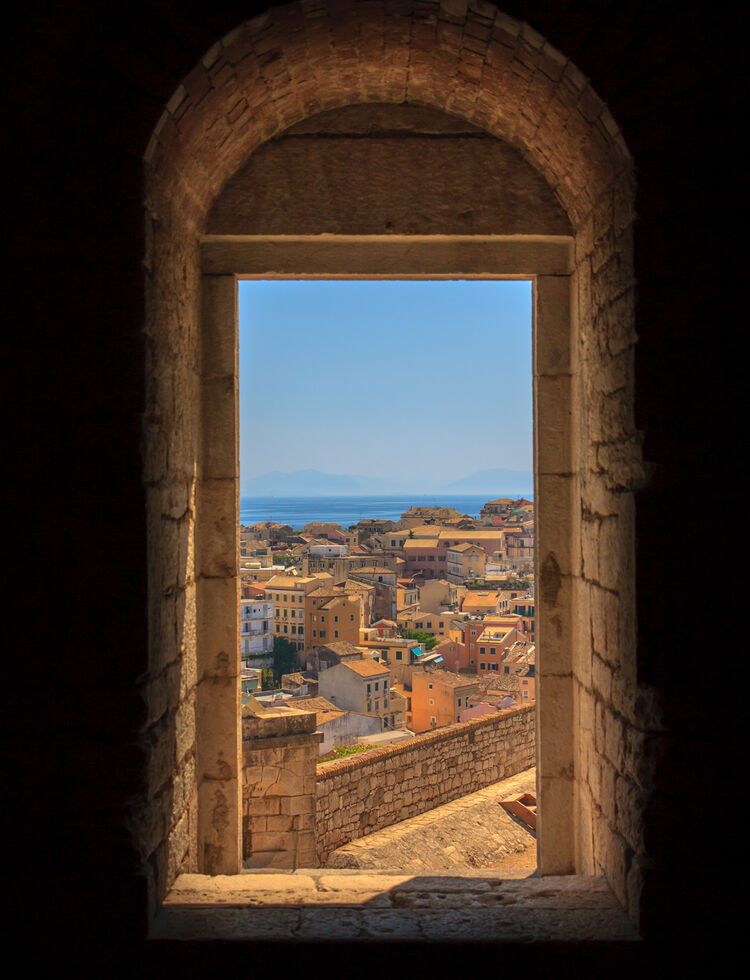

OVERVIEW
A walking tour of Corfu Old town
The Byzantines, Venetians, French and British all ruled over Corfu, giving this stellar island in the Ionian Sea a unique history that can be felt everywhere in the Old Town which has, in its entirety, been declared a UNESCO World Heritage Site.
You can see it in the architecture of the buildings located between the Old and New Venetian Fortresses and feel it as you explore the pedestrianised little roads called cantounia, as they wind their way through the town and lead to churches, palaces, art galleries and squares. And you can hear it in the music for which Corfu is famed and the banter of locals going about their daily lives.
There is an authenticity and romance to Corfu's Old Town that will leave you completely charmed.
DON'T MISS
Highlights of Corfu Old Town
You can mix and match attractions in Corfu’s Old Town according to your interests and time, but a walking tour covering the highlights would include:
Ionian Parliament
We start at the Ionian Parliament, on Moustoxides Street (the widest of the Old Town’s cantounia), where representatives of the region voted for the unification of the Ionian Islands with the rest of Greece in the 19th century. Before that, Corfu had been a protectorate of Britain for almost 50 years.
Town Hall
Turn left into Guildford Street (named after the British philhellene who, amongst other things, re-established the Ionian Academy). You’ll reach a square housing the Town Hall, formerly a club for noblemen and the Theatre of St Giacomo. You’ll also find the 16th-century Catholic Cathedral of San Giacomo. The square and surrounding roads are a hub for cafeterias and restaurants, with great shopping and nightlife.
Casa Parlante
Heading up to Nikiforou Theotoki Street, you find the Casa Parlante, a 19th-century mansion that’s now a museum recreating the life of a nobleman during this golden period in Corfu’s history.
Church of Agios Spyridon
Around the block is Agios Spyridon, a 15th-century church with an impressive bell tower. It houses relics of the island’s patron saint, Spyridon, who is said to have expelled the plague from the island. The relics form part of a procession every Palm Sunday. Leave by the exit that takes you into the Agios Spyridonas cantouni, with its souvenirs and local products.
Cosmopolitan Liston and Spianada Square
The road you are on ends at Liston, part of the Spianada, the Old Town’s main square. With its 19th-century colonnade modelled on Paris’ Rue de Rivoli, Liston is catwalk territory, perfect for an espresso and pose. But take a moment to walk through the grass-filled Spianada, with its fountain and café and open areas (where concerts and even cricket matches are played).
The Old Fortress
Built on a hill marking the eastern end of the city, the Old Fortress was started by the Byzantines and finished by the Venetians, when it was turned into an island. Walk over the canal, through the gates and on towards the Church of St George. Now climb to the cross at the top of the fortress and enjoy the panoramic views. There’s a public library, a Byzantine collection and a café within the grounds, as well as a small marina.
Boschetto Gardens & Garden of the People
Next to the Old Fortress are the Boschetto Gardens, perfect for a stroll with views of the fortress. If you want the greenery to continue, head to the Garden of the People, part of the Palace of St Michael & St George.
Palace of St Michael & St George
Originally the seat of the Order of Knights of Saint George and Saint Michael, this was once a British governor’s mansion and a summer residence for the Greek Royal Family. Today, it houses the Museum of Asian Art. The palace sits above the Faliraki district, with its tiny beach that’s perfect for a morning swim. It’s also a great spot for a summer evening cocktail with views of the lit-up Old Fortress.
Campiello
Continue into Campiello, the oldest and most atmospheric quarter, with its labyrinth of narrow cantounia, carved wells, picturesque squares and tall buildings with balconies that are often decorated with bougades (pots) and ropes. Check out the Venetian Well opposite the Church of Panagia Kremasti and the Metropolitan Church.
Dionysios Solomos Museum
Heading north, you’ll find a museum dedicated to Greece’s national poet, Dionysios Solomos, whose Hymn to Freedom was adapted into the Greek national anthem. The house in which he lived, wrote and died was destroyed during World War II but has been restored and converted into a museum.
New Fortress
From here, it’s a short walk west to the New Fortress (the Venetian’s 16th-century Fortezza Nuova), built on the hill of St Mark above the old port and once connected to the Old Fortress by a wall. The surrounding area is a lovely place to eat.
Jewish Quarter
Returning to the coast road, head down Xenofontos and then Velissariou streets, which flank the Old Town’s western side, until you reach the Synagogue. Corfu’s Jewish community, which dates from the 12th century, was persecuted during the Nazi occupation but played an important part in the island’s cultral and daily life. The area has some excellent tavernas.
The walk ends at the church of at Agia Sophia at the bottom of Velissariou, from where you turn left into Evgeniou Voulgareos St and walk to the 14th-century Annunziata (you’ll know it from its bell tower). The Ionian Parliament and Spianada Square are just a few minutes away.
GET PLANNING
Where do walking tours of Corfu Old Town start from?
- You can begin your walking tour wherever you like, but if you do choose the Ionian Parliament you can easily reach it by car, taxi or foot, depending on where you’re staying in town.
How do you get around Corfu Old Town?
- From the Port
To the New Fortress: 1.9km (bus No16)
To the Palace of St Michael and St George: 2.8km (bus No2)
- From the airport
To the Old Fortress: 2.4km
To Spianada Square and Liston: 2.2km (bus No.15 to Saroko Square and from there by foot)
Corfu has a good bus network within the town and from around the island.
More info
When is the best time to visit the Old Town of Corfu?
- Corfu’s Old Town is magical at any time of year, taking on a different atmosphere in each season.
- It can get crowded in the summer so it’s worth visiting in the quieter and cooler periods (May-June and September-October).
- If you do visit in the summer, start your walking tour early or in the afternoon to avoid the heat and crowds.
- Opening times and entry fees of museums and other cultural sites may vary between seasons.
- You can decide which sites to visit when you are there, or book a tour that includes entry to a selection (€40-€60).
- Private tours cost significantly more.
When are the museums and attractions of Corfu Old Town open?
- Opening times and entry fees of museums and other cultural sites may vary between seasons.
- You can decide which sites to visit when you are there or book a tour that includes entry to a selection (€40-€60). Private tours cost significantly more.
Museums and cultural sites opening times:
- Casa Parlante: Summer opening hours 10.00-18.00 daily. Open in winter upon request. Not suitable for visitors with disabilities. More info
- Museum of Asian Art: More info
- The Old Fortress: Limited access for visitors with disabilities.More info
- Boschetto Gardens & Garden of the People: Opening hours: 9.00-sunset.
- Dionysios Solomos Museum: Tickets €1. Not suitable for visitors with disabilities. More info
Easter is a particularly special experience in Corfu.
- Autumn
- Spring
- Summer
- Winter
How long do you need to explore Corfu island’s Old town?
- You will need a full day to complete the walking tour, with rests and lunch in between.
- Or you can spread it over a few days.
- Most organised tours last 3-4 hours and some private tours can last half the day.

